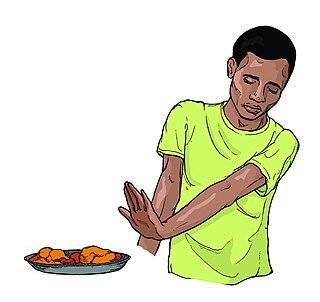
Inedia or breatharianism is the claimed ability for a person to live without consuming food, and in some cases water. It is a pseudoscientific practice, and several adherents of these practices have died from starvation or dehydration.

Anorexia is a medical term for a loss of appetite. While the term outside of the scientific literature is often used interchangeably with anorexia nervosa, many possible causes exist for a loss of appetite, some of which may be harmless, while others indicate a serious clinical condition or pose a significant risk.
An eating disorder is a mental disorder defined by abnormal eating behaviors that adversely affect a person's physical or mental health. These behaviors include eating either too much or too little. Types of eating disorders include binge eating disorder, where the patient keeps eating large amounts in a short period of time typically while not being hungry; anorexia nervosa, where the person has an intense fear of gaining weight and restricts food or overexercises to manage this fear; bulimia nervosa, where individuals eat a large quantity (binging) then try to rid themselves of the food (purging); pica, where the patient eats non-food items; rumination syndrome, where the patient regurgitates undigested or minimally digested food; avoidant/restrictive food intake disorder (ARFID), where people have a reduced or selective food intake due to some psychological reasons; and a group of other specified feeding or eating disorders. Anxiety disorders, depression and substance abuse are common among people with eating disorders. These disorders do not include obesity. People often experience comorbidity between an eating disorder and OCD. It is estimated 20–60% of patients with an ED have a history of OCD.

Bulimia nervosa, also known as simply bulimia, is an eating disorder characterized by binge eating followed by purging or fasting, and excessive concern with body shape and weight. This activity aims to expel the body of calories eaten from the binging phase of the process. Binge eating refers to eating a large amount of food in a short amount of time. Purging refers to the attempts to get rid of the food consumed. This may be done by vomiting or taking laxatives.
Fasting is abstention from eating and sometimes drinking. From a purely physiological context, "fasting" may refer to the metabolic status of a person who has not eaten overnight, or to the metabolic state achieved after complete digestion and absorption of a meal. Metabolic changes in the fasting state begin after absorption of a meal.

Starvation is a severe deficiency in caloric energy intake, below the level needed to maintain an organism's life. It is the most extreme form of malnutrition. In humans, prolonged starvation can cause permanent organ damage and eventually, death. The term inanition refers to the symptoms and effects of starvation. Starvation by outside forces is a crime according to international criminal law and may also be used as a means of torture or execution.

Appetite is the desire to eat food items, usually due to hunger. Appealing foods can stimulate appetite even when hunger is absent, although appetite can be greatly reduced by satiety. Appetite exists in all higher life-forms, and serves to regulate adequate energy intake to maintain metabolic needs. It is regulated by a close interplay between the digestive tract, adipose tissue and the brain. Appetite has a relationship with every individual's behavior. Appetitive behaviour also known as approach behaviour, and consummatory behaviour, are the only processes that involve energy intake, whereas all other behaviours affect the release of energy. When stressed, appetite levels may increase and result in an increase of food intake. Decreased desire to eat is termed anorexia, while polyphagia is increased eating. Dysregulation of appetite contributes to ARFID, anorexia nervosa, bulimia nervosa, cachexia, overeating, and binge eating disorder.
Promotion of anorexia is the promotion of behaviors related to the eating disorder anorexia nervosa. It is often referred to simply as pro-ana or ana. The lesser-used term pro-mia refers likewise to bulimia nervosa and is sometimes used interchangeably with pro-ana. Pro-ana groups differ widely in their stances. Most claim that they exist mainly as a non-judgmental environment for anorexics; a place to turn to, to discuss their illness, and to support those who choose to enter recovery. Others deny anorexia nervosa is a mental illness and claim instead that it is a lifestyle choice that should be respected by doctors and family.

Sarah Jacob was a Welsh child, one of the best-known of a number of so-called fasting girls of the 19th century in the United Kingdom and United States.
Some claim that the history of anorexia nervosa begins with descriptions of religious fasting dating from the Hellenistic era and continuing into the medieval period. A number of well known historical figures, including Catherine of Siena and Mary, Queen of Scots are believed to have suffered from the condition. Others link the emergence of anorexia to the distinctive presence of an extreme fear of being overweight despite being underweight which emerged in the second half of the 19th century and was first observed by Jean Martin Charcot and other French psychiatrists at the Salpetrière
Ellen West (1888–1921) was a patient of Dr. Ludwig Binswanger who had anorexia nervosa. She became a famous example of Daseinsanalysis who died by suicide at age 33 by poisoning herself.
Wannarexia, or anorexic yearning, is a label applied to someone who claims to have anorexia nervosa, or wishes they did, but does not. These individuals are also called wannarexic, "wanna-be ana" or "anorexic wannabe". The neologism wannarexia is a portmanteau of the latter two terms. It may be used as a pejorative term.
Joan Jacobs Brumberg is an American social historian and writes and lectures in the fields of women's history and medical history. Her first appointment at Cornell University (1979) was in Women's Studies and Human Development. From that point, her research, teaching and writing have been interdisciplinary and focused on gender. She is a Professor Emerita of Cornell University, and lectures and writes about the experiences of adolescents through history until the present day. In the subject area of Gender Studies, she has written about boys and violence, and girls and body image.

Anorexia mirabilis, also known as holy anorexia or inedia prodigiosa or colloquially as fasting girls, is an eating disorder, similar to that of anorexia nervosa, that was common in, but not restricted to, the Middle Ages in Europe, largely affecting Catholic nuns and religious women. Self-starvation was common among religious women, as a way to imitate the suffering of Jesus in his torments during the Passion, as women were largely restricted to causing themselves voluntary pain by fasting, whereas holy men experienced suffering through physical punishment.
The National Association of Anorexia Nervosa and Associated Disorders (ANAD) is the oldest organization aimed at fighting eating disorders in the United States. ANAD assists people struggling with eating disorders such as anorexia nervosa and bulimia nervosa and also provides resources for families, schools and the eating disorder community. Headquartered in Chicago, Illinois, ANAD is a non-profit organization working in the areas of support, awareness, advocacy, referral, education, and prevention.
Blaesilla, also known as Blesilla (364–384), was a Roman widow and disciple of Jerome. She was born into a wealthy senatorial family in Rome, the eldest daughter of Paula of Rome and sister of Eustochium, who were members of a group of wealthy Christian women who followed the teachings of Jerome. Blaesilla was widowed at the age of 18; at first, she enjoyed her freedom as a widow, but after a life-threatening fever, became "a changed woman" and a severe ascetic, practicing fasting as a spiritual discipline. Her fasts dramatically weakened her, and she died within four months, at the age of 20.

Anorexia nervosa (AN), often referred to simply as anorexia, is an eating disorder characterized by food restriction, body image disturbance, fear of gaining weight, and an overpowering desire to be thin.
The differential diagnoses of anorexia nervosa (AN) includes various types of medical and psychological conditions, which may be misdiagnosed as AN. In some cases, these conditions may be comorbid with AN because the misdiagnosis of AN is not uncommon. For example, a case of achalasia was misdiagnosed as AN and the patient spent two months confined to a psychiatric hospital. A reason for the differential diagnoses that surround AN arise mainly because, like other disorders, it is primarily, albeit defensively and adaptive for, the individual concerned. Anorexia Nervosa is a psychological disorder characterized by extremely reduced intake of food. People with anorexia nervosa tend to have a low self-image and an inaccurate perception of their body.
Drunkorexia is a colloquialism for anorexia or bulimia combined with an alcohol use disorder. The term is generally used to denote the utilization of extreme weight control methods to compensate for planned binge drinking. Research on the combination of an eating disorder and binge drinking has primarily focused on college-aged women, though the phenomenon has also been noted among young men. Studies suggest that individuals engage in this combination of self-imposed malnutrition and binge drinking to avoid weight gain from alcohol, to save money for purchasing alcohol, and to facilitate alcohol intoxication.

Henry Martyn Parkhurst was an American stenographer who served as Chief Official Court Reporter for the US Senate, an astronomer with pioneering work in Photometry, and an author. Parkhurst was an advocate of "Dianism".










